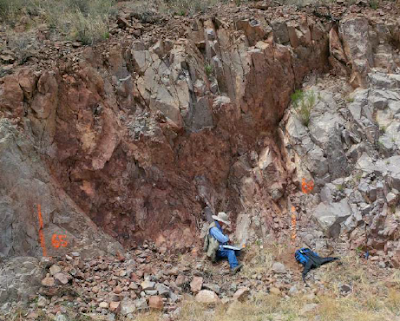Some companies can take months to release assays. We all know that these companies want to release those juicy numbers as quickly as possible, but sometimes, those evil pricks at the assay labs decide to screw everything up and deliberately go slow on those critical samples from that critical drill-hole from that critical project.
I mean, a Junior Exploration company would NEVER sit on assay results, especially if they aren't inline with market expectations/promises.
I need to take you on a trip, image that you are a little gold flake (or silver for weirdos), you've been lucky and managed to find yourself in a vein. If you've been lucky, you've ended up in a nice, warm location.
You've been there for millions (or longer) of years, an then, some dick-head geologist, probably a JAFA, whips out his Estwing, beats you out of place and then tosses you into a fine Sentry sample bag.
So, how long do you think it will take for this sample to go from the field, get crushed, analysed and the results e-mailed back to the incredibly talented exploration geologist?
(Note: I'm ignoring samples sent to mine laboratories, they have this weird think called 24 hour turnaround, that is way to little time to create an impressive story of your geological prowess).
There are 3 aspects in the life of a sample:
- How long it takes to get the sample from the field to the prep laboratory
- How long the Prep lab take to dry, crush, pulverize and sieve the sample to create a pulp
- How long it takes the pulp to arrive at the analytical lab and be analysed and the results sent to the company.
These factors vary by work rotation, project location, and location of the labs.
So, I've been going through some of my old data, and on average:
Peru - 28 days
From field to prep lab = 7 days
Prep = 3 days
Analysis - including over-limits - 18 days
Chile - 31 days
From field to prep lab = 8 days
Prep = 2 days
Analysis* - including over-limits - 21 days
Mexico - 25 days
From field to prep lab = 3 days
Preparation = 2 days
Analysis* = 14 days
*the pulp samples were sent overseas to Peru/Canada for 4 acid digest
These are AVERAGE turnaround times from hundreds of sample shipments. So, if we factor in a week or two for the geologists to import, process and interpret the results, you can see that 5-7 weeks is a good upper limit to wait for results to be announced.
So, if you are waiting >2 months for the results, maybe you should ask why......
Note: The samples form Chile and Peru were a combination of Core and surface (rock-chip, grab and soil samples). The Mexican samples were surface samples only.



